Dhamek Stupa, Sarnath

Technical Data
| Stamp Set | Bauddha Mahotsav Festival |
|---|---|
| Date of Issue | January 22, 2002 |
| Denomination | Rs. 4 |
| Quantity | 1,500,000 |
| Perforation | Syncopated 13½ x 13 |
| Printer | Calcutta Security Printers Ltd |
| Watermark | No Watermark |
| Colors | Multicolor |
| Catalog Codes |
Michel IN 1892 Stamp Number IN 1944 Yvert et Tellier IN 1656 Stanley Gibbons IN 2057 |
| Themes | Festivals | Musical Instruments | Religion | Temples |
Table of Contents
Commemorative Stamp Set: Dhamek Stupa, Sarnath
Design Elements:
The stamp featuring the Dhamek Stupa would present the grand cylindrical structure in all its architectural splendor, standing tall amidst the lush greenery of Sarnath. Detailed carvings of geometrical and floral designs that adorn the Stupa’s lower part could be highlighted. In the background, the Ashoka Pillar, symbolizing India’s national emblem, could subtly complement the design. A serene depiction of monks in meditation or pilgrims paying homage to the site may further capture the peaceful ambiance. Warm earthy tones, representing the brick and stone construction, would evoke the ancient yet timeless appeal of this sacred monument.
Cultural and Historical Significance:
The Dhamek Stupa marks the location in Sarnath where Lord Buddha delivered his first sermon, “Turning the Wheel of Dharma,” after attaining enlightenment. This event signaled the beginning of the spread of Buddhist teachings across the world. The Stupa is an important symbol of the Buddhist path, representing the Dharma and the Four Noble Truths that Buddha taught here. Sarnath itself is a revered pilgrimage site, and the Dhamek Stupa has become an iconic representation of the momentous occasion when Buddhism first took root as a global religion.
Usage:
This commemorative stamp could be used for promoting Indian heritage and Buddhism globally. It would serve as a collector’s item for philatelists, history enthusiasts, and Buddhists alike. It may also be used in special mail related to religious events, government tourism initiatives, and educational outreach focused on India’s cultural and spiritual landmarks.
Importance of the Commemorative Stamp Set:
Issuing a stamp set that includes the Dhamek Stupa highlights India’s role as the cradle of Buddhism. This site represents a critical turning point in religious history and underscores India’s importance as a destination for pilgrims from across the world. The stamp set would support efforts to promote heritage tourism and deepen international ties with countries that hold Buddhist history in high regard, fostering cultural diplomacy.
Example of the Stamp Design:
A prominent image of the towering Dhamek Stupa, set against the verdant landscape of Sarnath. The Ashoka Pillar might be depicted subtly in the background, symbolizing India’s rich cultural legacy. The Stupa’s intricately carved stonework could be accentuated, capturing the artistic craftsmanship of the time, while figures of monks in the foreground would symbolize ongoing reverence and devotion.
The commemorative stamp set might include:
- Dhamek Stupa, Sarnath – The site of Buddha’s first sermon.
- Mahabodhi Temple, Bodhgaya – The place of enlightenment.
- Gridhakuta Hills, Rajgir – Where Buddha delivered many of his sermons.
- Mahaparinirvana Temple, Kushinagar – The place where Buddha attained nirvana.
Significance:
The Dhamek Stupa stamp symbolizes the spiritual legacy of Buddha’s teachings, marking the first instance of the spread of Dharma. The set as a whole serves to commemorate India’s deep connection to Buddhism, fostering awareness and reverence for sites that are pivotal to global religious and cultural history.
